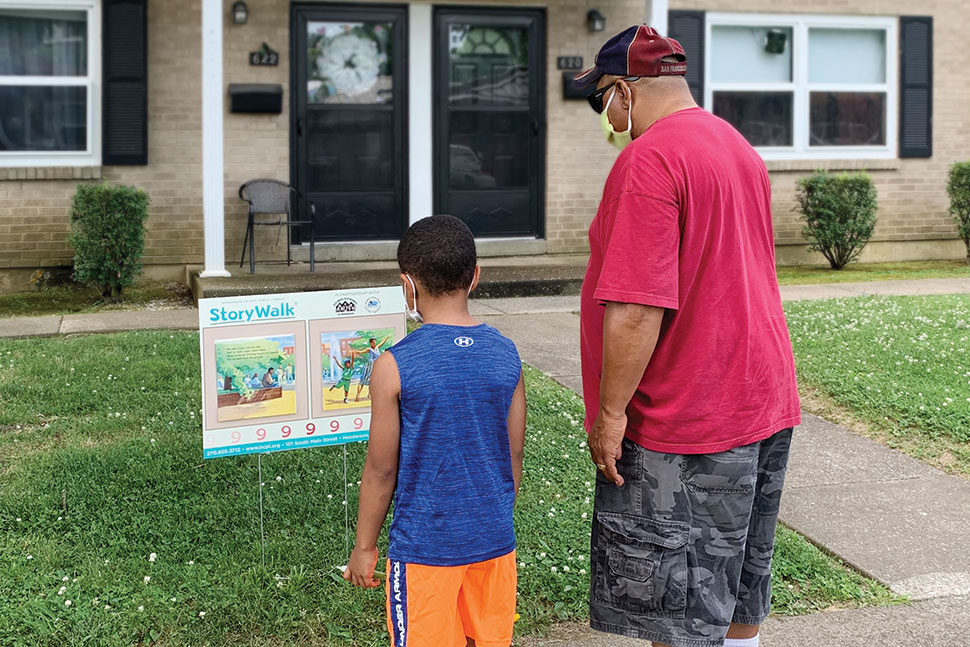Skip to the Next Page

Last year, Danielle Anguish, children’s services manager at Henderson County (Ky.) Public Library (HCPL), was tasked with coordinating a summer literacy activity for kids from seven elementary schools and four public housing developments. A daunting assignment in normal times, the program also had to adhere to the county’s COVID-19 lockdown protocols. Her solution? StoryWalks.
“It’s important that [kids] move, it’s important that they read, it’s important that they get outside,” says Anguish, “especially in a pandemic when nothing is the norm anymore.”
StoryWalks—outdoor paths that feature children’s book pages posted at a young reader’s height and take families on self-guided storytimes—are gaining traction in communities across the US and Canada. Noah Lenstra, founder and director of the Let’s Move in Libraries initiative, estimates that 825 online news articles on StoryWalk installations at public libraries were published between March 15 and December 18, 2020—a more than 400% increase from the same period a year before.
Anne Ferguson, the former Vermont Department of Health specialist who established the StoryWalk program 14 years ago in partnership with Kellogg-Hubbard Library in Montpelier, is not surprised by the surge.
“There’s gobs of research about the importance of getting out in nature, in terms of our own mental, physical, and spiritual health,” says Ferguson. During the pandemic, StoryWalks have allowed families to escape technology and just be playful, she says.
Creating a path
Ruth Fenchak, teen and outreach services leader at Sierra Vista (Ariz.) Public Library (SVPL), first learned about StoryWalks from a 2019 webinar hosted by the American Library Association’s Public Programs Office. It wasn’t until she was looking for a way to reach patrons amid pandemic protocols that she decided to start one at her own library.
“I didn’t want to leave the younger children behind,” says Fenchak, whose library was offering grab-and-go kits at the time but hadn’t developed much in the way of literacy activities for early readers.
For SVPL’s debut StoryWalk last September, Fenchak chose the picture book Bella’s Fall Coat by Lynn Plourde. She laminated the book pages, stuck them to plastic yard signs with heavy-duty Velcro, and inserted the signs into metal frames, like ones used by real estate companies to advertise houses. Frames were installed along the path of the library’s botanical garden. Fenchak continues to post new books on the path about every two months.
At the bottom of each StoryWalk frame, Fenchak includes discussion questions—for example, What are three things you see in this picture?—to provide caregivers with prompts to engage children in the material.
Engaging readers was HCPL’s goal as well. Anguish had previous experience starting a StoryWalk in a city park and thought the program’s portability would be ideal for reaching the county’s students. “Since we couldn’t have gatherings or in-house programming, this was a way to still bring summer reading to the community,” she says.
She selected three books (Jonathan and His Mommy by Irene Smalls, The Very Impatient Caterpillar by Ross Burach, and I Went Walking by Sue Williams) for her StoryWalks. Book pages were affixed to yard signs and rotated every few weeks among seven elementary schools and four public housing developments. HCPL used a hashtag to build awareness with caregivers on social media, and the schools held drive-through literacy nights with food and school supply giveaways, where they encouraged families to try the StoryWalks. At the housing developments, the Housing Authority of Henderson distributed snacks to children who showed up for the StoryWalk unveilings.
Watauga County (N.C.) Public Library (WCPL) in Boone, a branch of Appalachian Regional Library, had done StoryWalks in previous years but last summer wanted to bring its presence to the center of town. The library selected A Isn’t for Fox by Wendy Ulmer, an alphabet book, to help early readers with letter recognition. The book’s 26 letters were posted in the windows and doors of businesses in downtown Boone. Readers who shared photos of themselves on social media—or emailed them to the library—posing near a storefront’s letter received a free children’s book.
“For this particular StoryWalk, we wanted it to function more like a scavenger hunt,” says Lisa Flanigan, WCPL youth services librarian. “Families could enjoy [it] even if they did not participate in the entire StoryWalk,” she says. “We heard from [one] participant that their child made the connection that the page for letter F was on the door of the fire station.”
Partnership and payoff
While the StoryWalks at SVPL and HCPL were mainly funded through their libraries’ programming budgets, partners still played a role in their projects. The Kiwanis Club of Sierra Vista–San Pedro, for instance, covered costs for an outer space–themed StoryWalk at SVPL in November to coincide with a local museum’s planetary exhibit.
Partnering with the housing authority on a StoryWalk made sense for HCPL; the county’s housing developments have a high concentration of early readers, and the library works with the organization’s after-school and technology programs to offer homework help, literacy activities, and STEM projects.
Though WCPL’s StoryWalks have been partially funded by the Library Services and Technology Act’s Grants to States program—a 2014 systemwide award of $41,000 has helped finance at least 36 installations—the library continues to rely on collaborators. The Downtown Boone Development Association, for example, provided card stock and laminating supplies for WCPL’s alphabet hunt.
StoryWalks can be attractive for their low costs and reusable materials, but library workers say they especially value the joy these walks have provided during turbulent times. Fenchak witnesses this excitement in real time, from a floor-to-ceiling window that faces SVPL’s garden. “It is wonderful to see children enjoying something,” she says, “even if they can’t be in the building.”
Source of Article